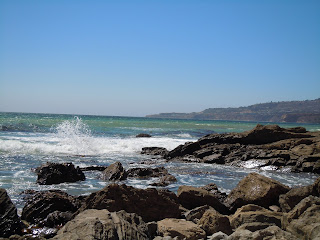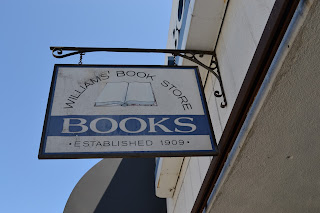The idea of being disappointed by leaving Texas at the end of August for a week of cloudy and cool Pacific life made me laugh.
All week the foghorn mooed, a sound that can't help but remind you that great ships are nearby though invisible. We took nice long walks, as we often do; this year down to Paseo del Mar. This is the area of Royal Palms, with its famous tide pools and formerly famous resorts, gone now. In a previous post I mentioned a chunk of Paseo del Mar that fell off a couple of years ago, just north of where I took this picture. (At least, I think it's north. San Pedro is a peninsula, and I come from a place where the large body of water means "east," so I could be all wrong. Anyway, up the road.)
When I'm here it's hard not to daydream about the old days, when coastal property was cheap and all the rich and famous drove to the seaside resorts and dance halls in limousines. I found a personal reminiscence by a San Pedro writer from 2011: http://www.dailybreeze.com/general-news/20111209/san-pedro-authors-history-of-white-point-comes-from-personal-experience. Make note of the Corner Store where she had her book signing; we'll be heading there before long.
Mary had been quite right in recommending warm clothing. Doubtless she was remembering the summer of 1989 when I drove out to live with her during my internship year. While she and her scantily-clad workmates played volleyball on the beach, I sat wrapped in sweatpants, sweatshirt, and a blanket. This year, we walked briskly to keep warm.
As we went about in this monochromatic salt-smelling landscape, nearly unable to tell where the sea left off and the sky began, I kept thinking about Sylvia Plath's line, "This is the sea, then, this great abeyance." Fortunately there were some spots of color to remind me I was still alive.
Pelicans never cease to amaze and amuse me. As they take off from the water they seem as unwieldy as pterodactyls. When they land on the water they always look surprised. And when they go from full flight arrowing down to snatch a fish, they look like torpedoes. I just love the pelicans.
Later in the week Mary and I would naturally spend time at the beaches: Redondo, Hermosa, Manhattan. It's what we do. One day when the sun was beginning to take a stand, I took the opportunity to see what I could do with my new polarized filter. Photography lessons are second on my list for the coming year. (First up: I have resolved to learn how to knit something that's not a hat, scarf, or shawl that I can actually wear.)
This is a part of Redondo Beach just north of Palos Verdes, where you park on a wide avenue of elegant condominiums and walk down 75 stairs to reach the strand. We encountered just a few people playing in the surf
a long sweep of coastline
and one sailboat off in the distance.
I have nothing original to say about the ocean, although I've written a poem or two with oceans in them, some of which I rather like. Not my words so much as what all large bodies of water evoke: a soothing, terrifying timelessness; a calming indifference to my troubles; all the best moments of my childhood. A professional-level insomniac, I sleep like a stone whenever a combination of salt water, warm sand, and the shouts of children at play are my environment. Even more than half a century later I can remember waking up from a nap in an upstairs room, the muslin sheets faintly sandy, the shrieks of kids across the street at the beach filling me with an urgent need to rush down the stairs and out the door to join them.
How do you explain a world in which you can feel at once completely alone and so deeply connected?
























































